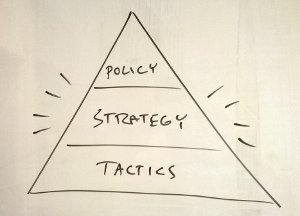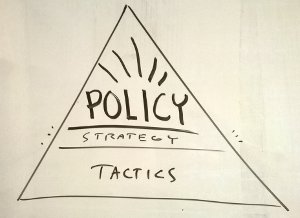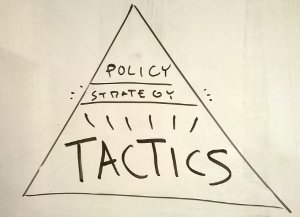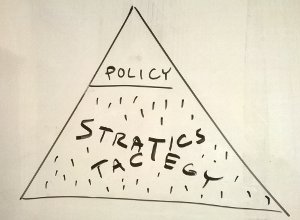A recent post by Steve Barrager on LinkedIn got me thinking about decisions, and in particular, the framing choices that lead to the identification of the focus decisions an analytical project will consider.
In many cases, the main decision is pretty obvious. Should we fund this R&D project? What should we bid for this lease? But even when the first decision comes easily there should be a measure of concern about missing something at a finer grain that might add value – either a creative alternative, or a secondary decision or future option. Yes we should fund that project, but is it worth throwing money at it to try to speed it up? Yes we should develop that field, but should we jump right to full capacity or build out in phases?
It’s not always that easy to find even the first decision. Framing can hit a brick wall in the search for a decision statement. At one extreme, there may be a problem without a decision. Think Lehman Bros on a certain fateful Sunday afternoon. You can analyze your angst as much as you want, but there may not be an alternative with any hope of resulting in an acceptable outcome. At the other extreme, an analysis can be paralyzed by too many possible actions/opportunities.
A useful construct for thinking about these issues is the decision hierarchy or pyramid. In the classic expression of the pyramid, there is a small “policy” triangle at the top, a broad “tactical” base at the bottom, and a middle “strategic” layer where the decisions of interest reside. The decision pyramid is a function of the charter (implicit or explicit) for the analysis project and also the culture, rules and policies of the organization making the decision.
A healthy decision pyramid
When the analysis project has a good, healthy pyramid, the decision statement stage of framing tends to go smoothly. If it’s a business decision within a company, they know what they do for a living, and they know how to do it. They have rules for staying out of trouble (health & safety, ethics, etc.), but there’s enough freedom that they can take advantage of opportunities, even when doing so requires a strategic shift or a dose of risk.
Not all decision pyramids are healthy.

Enlarged policy
Senior management needs to run the company, and in a large corporation they need to have sufficient controls in place to ensure that some rogue business unit doesn’t put the whole enterprise at risk. But there has to be some room to work strategically. Enlarged policy can keep a company too focused on its existing businesses and methods, and unable to explore promising new areas or even close adjacencies.

Tacticosclerosis
“This is the way we do it here”. Examples of this disorder can be seen in manufacturing companies that allow process considerations to hijack their product planning. Of course you have to be able to make the product at an acceptable cost, but the first consideration has to be the preferences of the customer, or there won’t be many customers. The ability to execute well can be a competitive advantage, but not if the implementation wizards are executing a doomed strategy.

Not all decision pyramid disorders involve a shrunken strategic layer, sometimes it’s actually too big:
Stratotechnical porosis
To be successful, a decision analysis project, and in particular a decision analysis model, needs to stay out of the weeds. Finding the right balance can be tricky; sometimes implementation issues do rise to a strategic level. But attempts to build “mission control” models which include both strategic alternatives and a large amount of lower level detail usually fail. The difficulty of getting those details right crowds out other considerations, to the detriment of decision quality.

Bottom Line: There are always plenty of things to be concerned about in framing, but if you give some thought to your pyramid, and are aware of the ways it can go wrong, you’re in good shape to flag the right decision(s) and have a successful analysis.